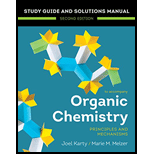
Concept explainers
(a)
Interpretation:
The complete mechanism for the reaction between the given Wittig reagent and benzaldehyde is to be drawn.
Concept introduction:
Wittig reactions generate the carbon double(
(b)
Interpretation:
The complete mechanism for the reaction between given Wittig reagent and benzaldehyde is to be drawn.
Concept introduction:
Wittig reactions generate the carbon double(
(c)
Interpretation:
The complete mechanism for the reaction between given Wittig reagent and benzaldehyde is to be drawn.
Concept introduction:
Wittig reactions generate the carbon double(
Want to see the full answer?
Check out a sample textbook solution
Chapter 17 Solutions
Organic Chemistry: Principles And Mechanisms: Study Guide/solutions Manual (second)
- Alkyl diazonium salts decompose to form carbocations, which go on to form products of substitution, elimination, and (sometimes) rearrangement. Keeping this in mind, draw a stepwise mechanism that forms all of the following products.arrow_forwardPlease provide a complete, detailed curved-arrow mechanism for the following reaction.Include ALL lone pairs and formal charges. Using the mechanism and a few words,explain the why the NaH deprotonates at the selected a-position and not the other a-position. Also explain why the indicated alkene is formed in the 3rd step rather than the other possible alkene product.arrow_forwardIdentify compounds A–D in the following reaction sequence.arrow_forward
- For a and b, arrange the following in increasing rate of reaction with HClarrow_forwardDraw the structure for the product formed in each of step of the following synthetic sequencesarrow_forwardHelp! Please explain in detail. Thank you! Avobenzone is an active component in many sunscreens. It can exist in an equilibrium between its keto and enol forms. The enol from of avobenzone is given below. (A) Draw the keto form of this compound (B) Which tautomer (keto or enol) exists in a higher equilibrium percentage? Explain your reasoning.arrow_forward
- Draw a general Mechanism for Nucleophilic Aromatic Substitution (NAS) reactionarrow_forwardProvide the mechanism and the structure of the products A and B in the given reactions. Explain the advantage of one over the other.arrow_forwardIdentify compounds A,C,I in the following reaction sequences.arrow_forward
 Organic Chemistry: A Guided InquiryChemistryISBN:9780618974122Author:Andrei StraumanisPublisher:Cengage Learning
Organic Chemistry: A Guided InquiryChemistryISBN:9780618974122Author:Andrei StraumanisPublisher:Cengage Learning
